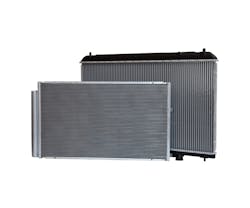After months of rigorous laboratory tests, Toyota engineers were ready to tackle real-world road testing of the new Toyota Genuine Radiator and Condenser product line in the harshest, extreme heat conditions. They found the ideal proving ground in the heart of California’s Mojave Desert. There, a stretch of road runs 31 miles along Interstate 15 from Baker, California, to Jean, Nevada. Temperatures reach up to 107 degrees and elevation jumps from 923 to over 4,700 feet. This route, named the Baker Grade, is infamous for its severe conditions and variables—which makes this desert road ideal for the ultimate test of quality.
Toyota engineers challenged vehicles equipped with their new radiator and condenser product line on the legendary Baker Grade. The results proved that even in the extreme heat and changing elevation, the new parts passed the test and performed up to Toyota’s quality standards.
All Toyota Genuine Parts are developed and tested from the beginning of the design process. Toyota emphasizes replacement part integrity. From the designers to the “takumis”, strict procedures ensure part accuracy and eliminate flaws throughout production.
Passing the Test
Before Toyota Genuine radiators and condensers hit the road, an extensive series of stringent laboratory tests must be executed and passed. Toyota Genuine Parts are tested to the same high-quality standards as new vehicle parts, and the quality control begins with checking individual parts relative to their original design standards.
Radiators, specifically, must pass six stringent tests before moving forward to road testing. The product testing criteria starts with radiation rate testing, followed by a ventilation resistance test, a passage resistance test, an air tightness test, a pressure resistance test, and, finally, a corrosion test.
On the other hand, condensers must pass the following exacting laboratory tests: heat radiation performance, air flow restriction, flow path resistance, residual foreign substance, tube strength, pressure resistance, damage, repeated pressurization, and corrosion resistance dewing.
Once all of the above individual tests have been executed and passed, the radiators and condensers move on to in-vehicle testing, ensuring the consistency, accuracy, and safety of the parts.
This then leads to the Baker Grade, where the radiators and condensers are tested in extreme conditions—radiator coolant temperatures, heat exchanger air temperatures, and A/C performance are all evaluated.
The Genuine Difference
Toyota’s dedication to testing is unwavering, and a stark contrast to its aftermarket competitors. Most aftermarket parts are typically developed after the vehicle goes on sale, and then rushed to market. Aftermarket parts can also be manufactured on the exact same production lines as other OEMs’ vehicle parts.
When faced with a repair decision involving an aftermarket part, consider the extensive testing procedures Toyota Genuine Parts go through in order to ensure their quality. This genuine difference allows for technicians to have an easier replacement process and for customers to have peace of mind that their radiators and condensers will be of the superior quality associated with Toyota.
Collision repair shops nationwide are touting the benefits of Toyota’s new Genuine Radiator and Condenser product line. Now they can ensure their repair processes meet Toyota standards for fit, function and reliability at “better than aftermarket” prices and with highly tested and quality genuine parts.
Contact your Toyota Genuine Wholesale Parts dealer for more information, or visit toyotapartsandservice.com.
About the Author
Sponsored Content
The views and opinions expressed in this piece do not necessarily reflect those of 10 Missions Media and its associated brands.
